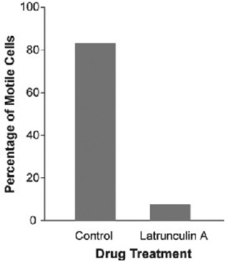Multiple Choice
Use the following information to answer the question.
The mechanism of cell crawling in protist species is not well defined. Pseudopodia extension involves interactions between actin and myosin (the same molecules that are involved in vertebrate muscle contraction) . However, prior to the study described below, no one had provided convincing data that actin and myosin were actually involved in cell crawling in protists. Anatomical studies had identified the cytoskeletal protein actin just below the surface of the cell membrane in several species of protist, but physiological studies had failed to show a functional link between actin, myosin, and cell crawling.
In a study by N. Poulsen et al. (Diatom gliding is the result of an actin-myosin motility system, Cell Motility and the Cytoskeleton 44 (1999) :23-22) , researchers tested whether motility in a particular species of diatom involves interactions between actin and myosin.
Refer to the study by Poulsen et al. and the figure above. Cultures of a species of diatom were treated with BDM, a reversible inhibitor of myosin function. Which of the following predictions is consistent with the hypothesis that an actin-myosin interaction is necessary for motility?
A) BDM will significantly decrease motility of the cells in culture.
B) BDM will not significantly alter motility of the cells in culture.
C) BDM will significantly increase motility of the cells in culture.
D) BDM will significantly increase motility of the cells in their natural habitats.
Correct Answer:

Verified
Correct Answer:
Verified
Q21: Which of the following groups is matched
Q36: Dinoflagellates _.<br>A) possess two flagella<br>B) are all
Q37: Which group is incorrectly paired with its
Q38: Prokaryotic and eukaryotic flagella _.<br>A) have the
Q42: Use the following information to answer the
Q43: Imagine that some members of an aquatic
Q44: The fact that amoebas are not monophyletic
Q45: Living diatoms contain brownish plastids. If global
Q46: Use the following information to answer the
Q48: Which of the following pairs of protists